Gabun |
|
|
|
| Übersicht – Contents: | |
Gabun |
|
|
|
| Übersicht – Contents: | |
Flaggen – Flags: |
|
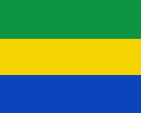 |
Nationalflagge – national flag, |
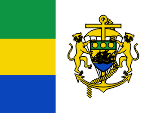 |
Marineflagge – naval flag, |
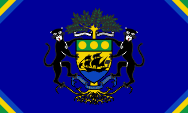 |
seit/since 2016, |
historische Flaggen – historical Flags: |
|
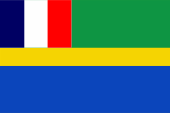 |
1959–1960, |
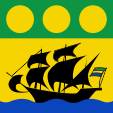 |
1960–1990, |
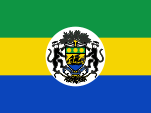 |
1990–2016, |
| Die am
28.11.1958 gegründete Autonome Republik Gabun erhielt am 29.06.1959 ihre
erste Flagge. Sie ähnelte bereits sehr stark der heutigen Flagge, jedoch war
der gelbe Streifen nur halb so breit, und die Oberecke der Flagge zeigte die
französische Trikolore. Die heutige Flagge wurde am 09.08.1960 offiziell eingeführt. Grün steht für die wirtschaftlich wichtigen Waldungen, Gelb für die Sonne und Blau für das Meer. Für Gabun werden die Farben Pantone pt 355, pt 109, und pt 293 angegeben. |
The on the 28th of November in 1958 established Autonomous Republic of Gabon received their first flag on 29th of June in 1959. She already very equals the today's flag, however the yellow stripe was only half wide, and the upper canton of the flag showed the French tricolor. The today's flag was officialy introduced on the 9th of august in 1960. Green stands for the economical important forests, yellow for the sun and blue for the ocean. The colors Pantone pt 355, pt 109, and pt 293 are given for Gabon. |
| Quelle/Source: Wikipedia (DE), Flaggen Wappen Hymnen, Flags of the World | |
| Wappen – Coat of arms: | |
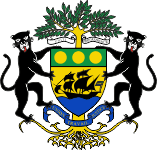 |
Das Wappen von Gabun – coat of arms of Gabon, Quelle/Source, nach/by: Wikipedia (DE), Corel Draw 4 |
| Das Staatswappen von Gabun wurde am 15.07.1963 eingeführt. Es zeigt ein unten spitz zulaufendes französisches Schild. Darin auf goldenem Grund ein schwarzes Segelschiff, es steht für Fortschrittswillen, oberhalb einer blauen Wasseroberfläche. Das Schildhaupt ist grün, es steht für die Wälder des Landes, und zeigt darin drei goldene Scheiben. Diese repräsentieren die Bodenschätze. Hinter dem Schild ein Baum, dessen Krone oberhalb, und dessen Wurzeln unterhalb des Schildes herausschauen. Oberhalb des Schildes ein weißes Spruchband mit dem Motto: "Uniti Progrediemur" → "vereint vorwärts", unterhalb des Schildes ein blaues Spruchband mit dem Staatswahlspruch: "Union, Travail, Justice" → "Einigkeit, Arbeit, Gerechtigkeit". Schildhalter sind zwei schwarze Panther. | The coat
of arms of the state of Gabon was introduced on 15th of July in 1963. It
shows a below to a top developing French shield. In it on golden ground a
black sailing ship above a blue water surface, it stands for will to
progress. The upper part of the shield is green, it stands for the forests
of the country, and shows in it three golden disks. Those represent the
mineral resources. Behind the shield a tree, protrude its Krone above and its radices below the shield. Above the shield a white typeface ribbon with the motto: "Uniti Progrediemur" →"united forward", below the shield a blue typeface ribbon with the motto of the state: "Union, Travail, Justice" → "unity, work, justice". Shield holders are two black panthers. |
| Quelle/Source: Flaggen Wappen Hymnen | |
Flugzeugkokarde – aircraft roundel: |
|
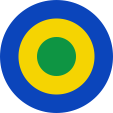 |
Flugzeugkokarde – aircraft roundel Quelle/Source, nach/by Wikipedia (EN) |
| Landkarten – Maps: |
Lage – Position: |
Landkarte des Landes – Map of the Country: |
| Zahlen und Fakten – Numbers and Facts: | |
|
|
|
|
|
|
|
|
|
|
|
|
|
|
|
|
|
|
| Quelle/Source: CIA World Factbook, Wikipedia (DE) | |
|
1471 · der Portugiese Diaz entdeckt die Küste des heutigen
Gabun 1839 · beginnende französische Kolonisierung 1886 · französische Kolonie 1888 · Gabun wird Teil von Französisch-Kongo 1910 · Gabun wird Teil von Französisch-Äquatorialafrika 28.11.1958 · autonome Republik 17.08.1960 · Frankreich gewährt Unabhängigkeit 1964 · Militärputsch, französische Intervention 1968 · Errichtung eines Einparteiensystems 1990 · Wiederzulassung eines Mehrparteiensystems, seither immer wieder Unruhen 2019 · Putschversuch des Militärs 2023 · Militärputsch |
|
1471 · the Portugese Diaz discovers the coast of the
today's Gabon 1839 · beginning French colonization 1886 · French colony 1888 · Gabon becomes a part of French Congo 1910 · Gabon becomes a part of French Equatorial Africa 28th od November in 1958 · autonomous republic 17th of August in 1960 · France grants independence 1964 · military revolt, French intervention 1968 · establishment of a one-party-system 1990 · re-permission of a multi-party-system, since then repeatedly riots 2019 · attempted coup by the military 2023 · military coup d’état |
| Quelle/Source: Weltgeschichte, Flaggen Wappen Hymnen, Wikipedia (DE) |
| Der Landesname "Gabun" ist portugiesischen Ursprungs, und geht auf das Wort "gabão", was Mantel heißt, zurück. Es ist eine Anspielung auf dort in der Entdeckerzeit immer wieder auftretende dichte Nebel, die alles wie ein Mantel einhüllten. | The country's name "Gabon" is of Portuguese origin, and goes back to the word "Gabão" which means coat. It is an allusion to the in the age of the discoveries there again and again occurring dense fog that everything enveloped like a coat. |
| Quelle/Source: Wikipedia (DE) | |